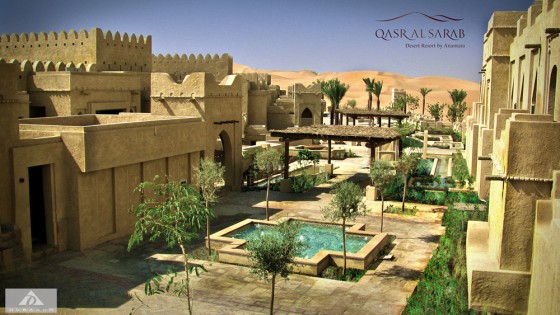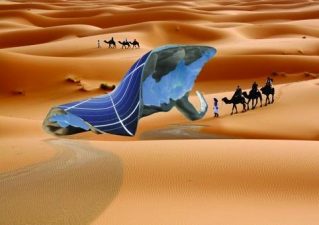 We applaud Dubarch’s steps towards sustainability, but is a 70 hectare 5 star resort in no-man’s-land a good idea?
We applaud Dubarch’s steps towards sustainability, but is a 70 hectare 5 star resort in no-man’s-land a good idea?
The Tourist Development & Investment Company of Abu Dhabi (TDIC) started developing a resort in the vast and uninhabitable area outside the capital called the Empty Quarter. Architects Dubarch designed what will be a high-profile, luxury 5 star resort based on indigenous knowledge. There is no doubt that the renderings of the Qasr Al Sarab Desert Resort and Spa are beautiful. And we love that the designers have planned to use local materials, water-sparing indigenous flora, and smart design that will make this resort energy efficient. But we aren’t thrilled about plans to build a luxury resort for rich folks in no-man’s land.

Dubarch claims that the building will incorporate a local Arabic theme in keeping with Abu Dhabi’s Bedouin heritage. Since the desert dwellers had to build clever buildings, the design will also serve a functional purpose.
Using local stucco and stone for construction materials will not only cut down on the building’s carbon footprint and provide much needed insulation from the exterior heat, but will imitate the traditional mud structures lost to the more contemporary, decidedly impractical glass towers that shimmer along the Gulf (the resort looks a lot like these Hassan Fathy buildings, no?)
The windows and door frames also hearken the longstanding Bedouin tradition on which the UAE is based, while also provided thermal insulation. And all of the landscaping – including trees and palm – will be done using indigenous flora that does not require a lot of water to survive.
UPDATE: the developers contacted us with more sustainability specs that dramatically changes our understanding of this development. They are numerous, but there are a few:
Sustainability
- In order to minimise the harsh effects of wind and sandstorms a wind modelling technique was used to select the best location for the development.
- Water consumption will be reduced by applying best practices for plant irrigation and outdoor landscape design. For example, an on-site sewage treatment plant will recycle water for non-potable re-use.
- During construction of the resort, concrete requirements were minimised by using geo-textile sandbags to build retaining walls – a sustainable application that uses local material, reduces cost, and significantly reduces the considerable carbon footprint from concrete.
- Specially designed double glazing windows will have recesses, overhangs and balconies to reduce heat transfer in all the buildings.
- On-site natural water resources will be conserved by Avoiding environmental impact on aquifers by not drawing from on-site natural water resources
- Architectural landscape has been carefully considered by selecting plants and trees that are tolerant of sand, wind and drought.
- All buildings will have intelligent building management system (IBMS), as well as intelligent lighting and energy control, thus reducing excessive and unnecessary use of electricity.
There is no question that the 70 hectare resort takes important strides towards sustainability. But there is a reason that this is called the Empty Quarter, and we worry that dominating it with technology (and wealth) goes against nature’s grain.
More Architecture in the Middle East
Hassan Fathy is the Father of Middle Eastern Architecture
What Happened to Islam’s Environmentally Friendly Architecture?
Nabito Architects to Build Amazing Spiral Skyscraper for Abu Dhabi





Iam really glad to read the update and thank you,i really never knew of the empty quarter.
True,quite impressive.
Qasr al sarab-nice renderings….
Can you please tell me what is Empty Quarter?i didnt get that.
Sir Hassan Fathy’s arhitecture however luxurious is always serene and understated.Isnt it?This qasr is a tad bit pompous,i guess intended.Nevertheless the step gets the applause.
Hi Sameera. This is what the developers say of Qasr Al Sarab: • Qasr Al Sarab (‘Mirage Palace’) is set amidst Abu Dhabi’s towering and awe-inspiring dunes in the Liwa desert, which is part of the Rub Al Khali (Empty Quarter), one of the world’s largest uninterrupted deserts. Agreed that this is more grandiose than Hassan Fathy, but I’ve learned even more about the sustainability stats and it really is quite impressive.